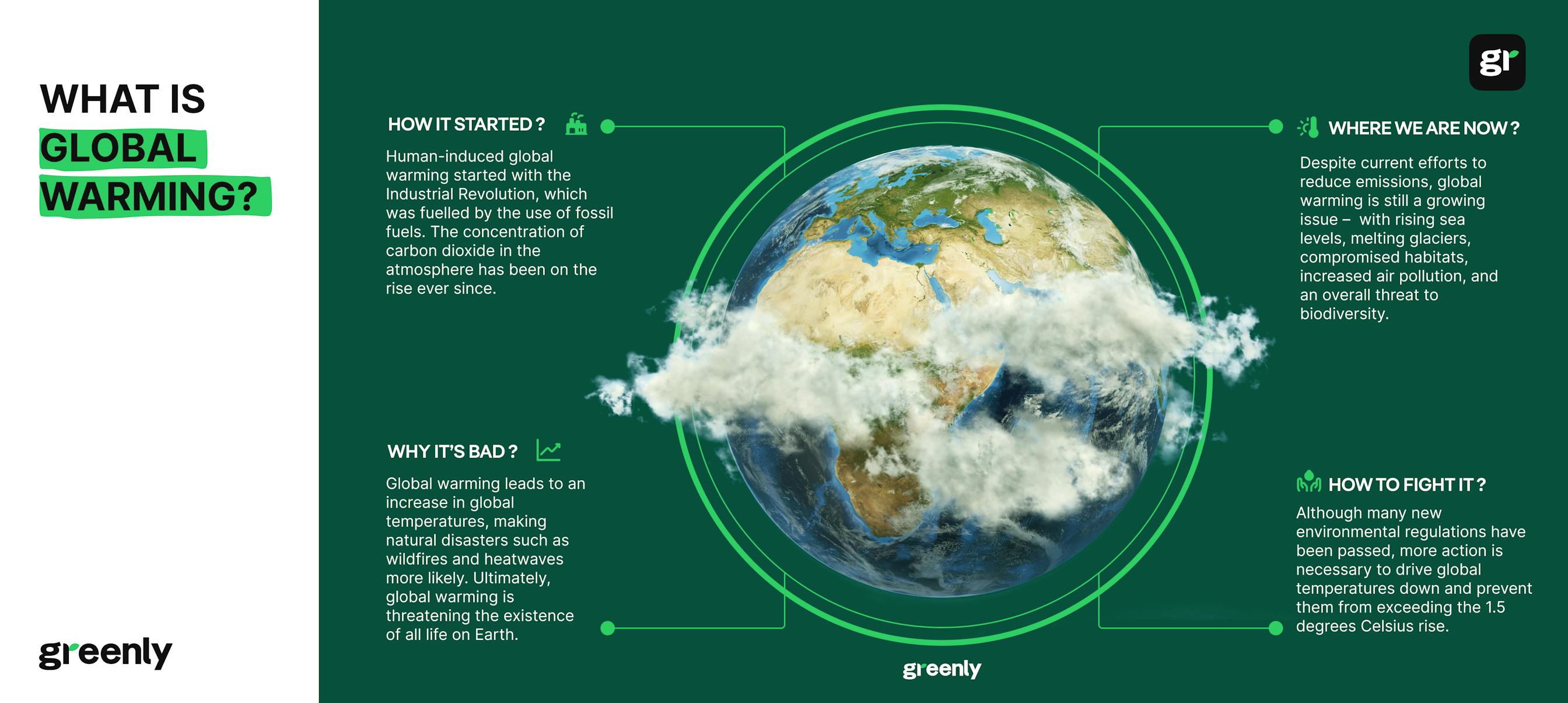ESG / CSR
Industries
Key Things to Know About Urban Heat Islands



Cities are getting hotter, and not just because of global warming. Urban areas tend to trap and amplify heat, creating localised “hot spots” known as urban heat islands (UHIs). These pockets of elevated temperature can push city thermometers several degrees higher than surrounding rural areas, with serious consequences for human health, energy demand, and even air quality.
In this article, we’ll break down what urban heat islands are, why they happen, how climate change is making them worse, and what cities can do to cool things down.
What are urban heat islands? An overview
Urban heat islands refer to the phenomenon where urban areas experience significantly higher temperatures than their rural surroundings. This temperature difference arises because cities, with their dense concentrations of buildings, roads, and other infrastructure, absorb and retain more heat than natural landscapes. The materials commonly used in urban construction - such as asphalt, concrete, and brick - are excellent at soaking up the heat during the day and slowly releasing it at night, leading to consistently higher temperatures in cities.
Cities often experience mid-afternoon temperatures that are significantly higher than surrounding areas - a critical time when heat-related health risks peak. But it’s not just a daytime problem. Cities can stay warmer well into the night, offering little relief after sunset and making heat waves even more dangerous for urban populations.
Urban heat islands also make many existing problems worse. Higher temperatures drive up the need for air conditioning, increasing energy use and greenhouse gas emissions. They also fuel the formation of ground-level ozone – a major component of smog, which poses serious risks to human health, especially for vulnerable populations like children, the elderly, and those with respiratory conditions.
What causes the heat island effect?
Urban heat islands are the result of a combination of factors that are largely driven by the way cities are built and maintained. This includes:
| Cause | Description |
|---|---|
| Surface Materials | The widespread use of heat-absorbing materials like asphalt, concrete, and brick in urban environments significantly contributes to urban heat islands. These materials have high thermal mass, absorbing heat energy during the day and releasing it slowly at night, leading to higher temperatures. |
| Limited Green Spaces | Vegetation helps cool the environment through shading and evapotranspiration, where plants release water vapour into the air. However, urban areas often lack green spaces, resulting in fewer natural cooling mechanisms and higher temperatures. |
| Energy Use | Increased energy consumption in cities for heating, cooling, and lighting generates waste heat, which is released into the environment and contributes to warming. The concentration of vehicles, industrial activities, and air conditioning systems further elevates urban temperatures. |
| Urban Geometry | The design and layout of cities, with tall buildings and narrow streets, create the "urban canyon effect," trapping warmer air and reducing airflow. This dense urban geometry limits natural cooling processes, exacerbating the heat island effect. |
Is climate change making urban heat islands worse?
Urban heat islands and climate change don’t just coexist, they fuel each other. As global temperatures rise, cities are getting even hotter, creating a vicious cycle that makes life in urban areas more uncomfortable, more energy-intensive, and more dangerous during extreme heat.
Here’s how climate change is making the urban heat island effect worse:


What are the impacts of urban heat islands?
Urban heat islands don’t just make cities hotter, they affect everything from our health and environment to how we live, work, and move around. Their impacts ripple through daily life, with consequences for public health, the economy, and the climate.
When cities overheat, everything works harder. Hospitals see a spike in heat-related illnesses, including heatstroke and respiratory distress, which the Environmental Protection Agency identifies as major risks during extreme heat events. In extreme cases, heat-related mortality can even occur.
Power grids groan under the weight of air conditioning demand. Public transport slows or stalls as rails and roads buckle in the heat. For city planners, it’s a constant game of catch-up, and for residents, it means less reliable services when they’re needed most.
Running fans and air conditioning around the clock isn’t cheap. For many households, especially in low-income areas, staying cool means stretching already tight budgets or going without. Cities, meanwhile, face rising costs to maintain and retrofit infrastructure, upgrade public buildings, and roll out green cooling solutions.
Heat changes how people use a city. Playgrounds, parks, and pavements sit empty under the midday sun. Outdoor events get cancelled. People retreat indoors, limiting exercise, socialising, and community life. Over time, this can chip away at residents’ mental and physical well-being, particularly in cities already struggling to offer enough liveable public space.
Unchecked, urban heat islands make cities less resilient, not just to climate change, but to all kinds of shocks. Ageing infrastructure breaks down faster under heat stress. Pollution builds. Vulnerable communities face mounting health risks. And the longer cities delay action, the harder (and costlier) it becomes to fix.
Why is heat also a justice issue?
Low-income and marginalised communities typically have fewer trees, less green space, and more paved surfaces. Buildings are older, insulation is poorer, and access to cooling is limited. These factors combine to create urban “heat traps” where temperatures can be several degrees higher than in wealthier, leafier districts just a few streets away.
This is no coincidence. In many cities, historically racist policies like redlining and discriminatory zoning shaped neighbourhood development. Areas marked as “undesirable” on mid-20th century maps were often denied funding, tree planting, and infrastructure upgrades - legacies that still determine which parts of a city bear the brunt of extreme heat today.
Addressing urban heat islands isn’t just about cooling cities, it’s also about correcting structural inequality. That means prioritising tree planting, green infrastructure, and heat-resilient design in communities that have been left behind. It also means involving residents in planning decisions to ensure solutions reflect local needs.
When done right, heat mitigation can improve quality of life, reduce health risks, and bring long-overdue investment to the neighbourhoods that need it most. Climate resilience starts with climate fairness.
How do urban heat islands affect the climate system?
Urban heat islands don’t just make cities hotter, they can also nudge the climate in unexpected ways.
While their impact is local, large urban areas can subtly influence broader atmospheric systems. The intense heat retained by cities alters airflow, disrupts precipitation, and raises local temperatures, sometimes triggering small-scale weather patterns like localised thunderstorms.. These changes affect not only urban microclimates but also surrounding regions, particularly where urban areas are densely clustered.
In this sense, urban heat islands aren’t just reacting to climate change, they’re becoming active agents within it. Addressing them isn’t only about protecting cities; it’s about stabilising the systems that connect them.
How can we reduce the impact of urban heat islands?
Mitigating the effects of urban heat islands is essential for creating more sustainable and livable cities. Fortunately, there are several strategies that cities can implement to reduce the intensity of UHIs, lower temperatures, and improve the overall urban environment. These strategies range from increasing green spaces to adopting innovative building materials and improving urban planning.
Here are some of the most effective approaches:
One of the most effective ways to mitigate extreme urban heat is by increasing the amount of vegetation in urban areas. Green infrastructure, including parks, tree-lined streets, green roofs, and urban gardens, provides shade and cools the air through evapotranspiration.
Trees and plants not only reduce the heat absorbed by urban surfaces but also improve air quality and enhance the appeal of cities. Urban forestry programmes and the creation of green corridors can significantly lower temperatures and create cooler microclimates within cities.
The materials used in urban construction play a key role in the formation of urban heat islands. Cool roofs and cool pavements are designed to reflect more sunlight and absorb less heat than traditional materials.
Cool roofs are typically made from reflective materials that can lower the surface temperature of buildings, reducing the need for air conditioning. Similarly, cool pavements are designed to reflect more solar energy and enhance water evaporation, which helps cool the surrounding environment.
These technologies can be especially beneficial in densely built urban areas where traditional surfaces contribute significantly to heat retention.
Thoughtful urban building materials, design, and planning are key to mitigating the urban heat island effect. Cities can be designed to maximise natural ventilation, reduce the heat trapped by buildings, and increase the overall cooling capacity of urban environments.
For example, wider streets and open spaces can enhance airflow, while the strategic placement of buildings and green spaces can help reduce heat buildup. Additionally, zoning regulations that encourage the development of green roofs, green walls, and permeable surfaces can further reduce the UHI effect.
Reducing energy consumption in cities is another crucial strategy for reducing urban heat islands. By improving the energy efficiency of buildings, cities can decrease the amount of waste heat released into the environment.
This can be achieved through better insulation, energy-efficient windows, and the use of renewable energy sources such as solar and wind power. Energy-efficient appliances and lighting can also contribute to lower overall energy demand, reducing the heat generated by urban areas.
Incorporating water features into urban landscapes, such as fountains, ponds, and rivers, can help cool the surrounding air through the process of evaporation. Referred to as blue infrastructure, this includes natural and man-made water bodies. These structures help reduce urban temperatures and create pleasant microclimates.
Educating the public about the causes and impacts of UHIs can encourage community involvement in green initiatives, such as tree planting and energy conservation. Governments and local authorities can also play a role by enacting policies that promote sustainable urban development, such as building codes that require cool roofs or incentives for green infrastructure projects.
Cities taking action: What’s working around the world
From cool pavements to urban forests, these case studies highlight how different strategies can help lower temperatures and improve urban resilience.
Singapore: A city in a garden
Singapore has embraced greenery as a core element of its urban design. Through initiatives like the Skyrise Greenery Incentive Scheme, the city has integrated vertical gardens, green roofs, and water-sensitive urban design into its dense built environment. Iconic buildings such as the Oasia Hotel Downtown and CapitaSpring are wrapped in living plant façades, helping cool the surrounding air and reduce surface temperatures.
Los Angeles: Testing cool pavements
In Los Angeles, reflective pavement coatings have been trialled to counter extreme surface heat, which is more readily absorbed by dark surfaces. In the Pacoima neighbourhood, streets treated with “cool pavement” technology saw surface temperatures drop by up to 10–12°C. The project is part of the GAF Cool Community Program, which focuses on helping low-income areas most exposed to heat. While results show promising temperature reductions, experts note that combining this with urban greenery yields the greatest benefits.
Melbourne: Growing an urban forest
Melbourne has set out to double its tree canopy cover from 22% to 40% by 2040 through its Urban Forest Strategy. Since its launch, more than 33,000 trees have been planted, cooling urban areas by up to 4°C in some locations. The city’s approach prioritises biodiversity, community engagement, and heat resilience, proving that long-term planning and investment can reshape the urban landscape.
New York City: Mapping heat to guide equity
New York has taken a data-driven approach to tackling the urban heat island effect. Through its Cool Neighborhoods NYC program, the city has mapped the most heat-vulnerable areas (often low-income neighbourhoods with limited tree cover) and directed resources to plant thousands of trees, expand green infrastructure, and create cooling centres. The initiative combines environmental planning with social equity to reduce heat risk for the most exposed communities.
Looking Forward
Urban heat islands are a growing challenge for expanding cities as the climate continues to warm. These hotspots not only intensify environmental and health issues but also contribute to global warming through increased energy use.
However, there are effective strategies to combat their impacts. By greening urban spaces, enhancing energy efficiency, and rethinking city design, we can cool our cities and create more sustainable, resilient environments.
Addressing urban heat islands will be crucial in making cities livable and sustainable for generations to come. The actions we take now will shape the health, comfort, and resilience of our urban landscapes in a warming world.
How Can Greenly Help Your Company?
At Greenly, we help organisations take meaningful climate action by measuring, understanding, and reducing their carbon emissions - a critical step in creating healthier, more resilient cities.
Our suite of carbon management services includes:
- Comprehensive carbon accounting across Scope 1, 2, and 3 emissions
- Tailored action plans to help reduce emissions and improve sustainability performance
- Supplier engagement and low-carbon procurement strategies to build greener value chains
- Regulatory alignment and reporting support, including CSRD, SBTi, and other global frameworks
- Sector-specific insights and tools adapted to the unique challenges of your industry
Urban heat islands highlight the urgent need for smarter, more sustainable systems, and that starts with understanding where emissions come from and how to reduce them. That’s where Greenly comes in. Get in touch with us today to find out more.











